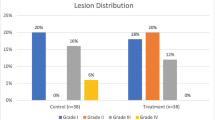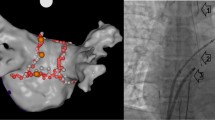Abstract
Background
Severe endoscopically detected esophageal thermal lesions (EDELs) have been associated with higher risk of progression to atrio-esophageal fistula (AEF) following radiofrequency catheter ablation (RFCA) of atrial fibrillation (AF). We sought to evaluate safety and feasibility of active esophageal cooling using the Attune Medical Esophageal Heat Transfer Device (EnsoETM) to limit frequency or severity of EDELs.
Objective
We sought To evaluate safety and feasibility of active esophageal cooling using the Attune Medical Esophageal Heat Transfer Device (EnsoETM) to limit frequency or severity of EDELs
Methods
Consecutive patients undergoing first-time RFCA were randomized in a 1:1 fashion to esophageal cooling (device group) or standard temperature monitoring (control group). Ablation on the posterior wall was performed with a maximum power of 30W for up to 20s. All patients underwent EGD within 48 h. Endoscopy findings were classified as 1, erythema–mild injury; 2, superficial ulceration–moderate injury; 3, deep ulceration–significant injury; and 4, fistula/perforation. Severe EDELs were defined as grade 3 or 4 lesions.
Results
Forty-four patients completed the study (22 device group, 22 control group). Adjunctive posterior wall isolation was performed more frequently in the device group (11/22, 50% vs. 4/22, 18%). EDELs were detected in 5/22 (23%) control group patients, with mild or moderate injury in 2/5 patients (40%) and severe thermal injury in 3/5 patients (60%). In the device group, EDELs were detected in 8/22 (36%) patients, with mild or moderate injury in 7/8 (87%) patients and severe thermal injury in 1/8 (12%) patients. There was no acute perforation or AEF during follow-up.
Conclusions
Active esophageal cooling may reduce the occurrence of severe EDELs. A larger randomized study is warranted to further evaluate the benefit of this strategy.




Similar content being viewed by others

References
Miyasaka Y, Barnes ME, Gersh BJ, Cha SS, Bailey KR, Abhayaratna WP, et al. Secular trends in incidence of atrial fibrillation in Olmsted County, Minnesota, 1980 to 2000, and implications on the projections for future prevalence. Circulation. 2006;114:119–25.
Calkins H, Hindricks G, Cappato R, Kim YH, Saad EB, Aguinaga L, et al. 2017 HRS/EHRA/ECAS/APHRS/SOLAECE expert consensus statement on catheter and surgical ablation of atrial fibrillation. Heart Rhythm. 2017;14:e275–444.
Dagres N, Anastasiou-Nana M. Prevention of atrial-esophageal fistula after catheter ablation of atrial fibrillation. Curr Opin Cardiol. 2011;26:1–5.
Halbfass P, Pavlov B, Muller P, Nentwich K, Sonne K, Barth S, et al. Progression from esophageal thermal asymptomatic lesion to perforation complicating atrial fibrillation ablation: a single-center registry. Circ Arrhythm Electrophysiol. 2017;10.
Kapur S, Barbhaiya C, Deneke T, Michaud GF. Esophageal injury and atrioesophageal fistula caused by ablation for atrial fibrillation. Circulation. 2017;136:1247–55.
Tschabrunn CM, Silverstein J, Berzin T, Ellis E, Buxton AE, Josephson ME, et al. Comparison between single- and multi-sensor oesophageal temperature probes during atrial fibrillation ablation: thermodynamic characteristics. Europace. 2015;17:891–7.
Carroll BJ, Contreras-Valdes FM, Heist EK, Barrett CD, Danik SB, Ruskin JN, et al. Multi-sensor esophageal temperature probe used during radiofrequency ablation for atrial fibrillation is associated with increased intraluminal temperature detection and increased risk of esophageal injury compared to single-sensor probe. J Cardiovasc Electrophysiol. 2013;24:958–64.
Muller P, Dietrich JW, Halbfass P, Abouarab A, Fochler F, Szollosi A, et al. Higher incidence of esophageal lesions after ablation of atrial fibrillation related to the use of esophageal temperature probes. Heart Rhythm. 2015;12:1464–9.
Oral H, Siontis KC. Prevention of atrioesophageal fistula after catheter ablation: if the esophagus cannot stand the heat (cold), can it be moved to the sidelines? JACC Clin Electrophysiol. 2017;3:1155–7.
Palaniswamy C, Koruth JS, Mittnacht AJ, Miller MA, Choudry S, Bhardwaj R, et al. The extent of mechanical esophageal deviation to avoid esophageal heating during catheter ablation of atrial fibrillation. JACC Clin Electrophysiol. 2017;3:1146–54.
Tran VN, Kusa S, Smietana J, Tsai WC, Bhasin K, Teh A, et al. The relationship between oesophageal heating during left atrial posterior wall ablation and the durability of pulmonary vein isolation. Europace. 2017;19:1664–9.
Arruda MS, Armaganijan L, Di Biase L, Rashidi R, Natale A. Feasibility and safety of using an esophageal protective system to eliminate esophageal thermal injury: implications on atrial-esophageal fistula following AF ablation. J Cardiovasc Electrophysiol. 2009;20:1272–8.
John J, Garg L, Orosey M, Desai T, Haines DE, Wong WS. The effect of esophageal cooling on esophageal injury during radiofrequency catheter ablation of atrial fibrillation. J Interv Card Electrophysiol. 2020;58:43–50.
Leung LW, Gallagher MM, Santangeli P, Tschabrunn C, Guerra JM, Campos B, Hayat J, Atem F, Mickelsen S and Kulstad E. Esophageal cooling for protection during left atrial ablation: a systematic review and meta-analysis. J Interv Card Electrophysiol. 2019.
Montoya MM, Mickelsen S, Clark B, Arnold M, Hanks J, Sauter E, et al. Protecting the esophagus from thermal injury during radiofrequency ablation with an esophageal cooling device. J Atr Fibrillation. 2019;11:2110.
Sohara H, Satake S, Takeda H, Yamaguchi Y, Nagasu N. Prevalence of esophageal ulceration after atrial fibrillation ablation with the hot balloon ablation catheter: what is the value of esophageal cooling? J Cardiovasc Electrophysiol. 2014;25:686–92.
Lin D, Frankel DS, Zado ES, Gerstenfeld E, Dixit S, Callans DJ, et al. Pulmonary vein antral isolation and nonpulmonary vein trigger ablation without additional substrate modification for treating longstanding persistent atrial fibrillation. J Cardiovasc Electrophysiol. 2012;23:806–13.
Halm U, Gaspar T, Zachaus M, Sack S, Arya A, Piorkowski C, et al. Thermal esophageal lesions after radiofrequency catheter ablation of left atrial arrhythmias. The American journal of gastroenterology. 2010;105:551–6.
Martinek M, Bencsik G, Aichinger J, Hassanein S, Schoefl R, Kuchinka P, et al. Esophageal damage during radiofrequency ablation of atrial fibrillation: impact of energy settings, lesion sets, and esophageal visualization. J Cardiovasc Electrophysiol. 2009;20:726–33.
Berjano EJ, Hornero F. A cooled intraesophageal balloon to prevent thermal injury during endocardial surgical radiofrequency ablation of the left atrium: a finite element study. Physics in Medicine and Biology. 2005;50:N269–79.
Lequerica JL, Berjano EJ, Herrero M, Hornero F. Reliability assessment of a cooled intraesophageal balloon to prevent thermal injury during RF cardiac ablation: an agar phantom study. Journal of cardiovascular electrophysiology. 2008;19:1188–93.
Tsuchiya T, Ashikaga K, Nakagawa S, Hayashida K, Kugimiya H. Atrial fibrillation ablation with esophageal cooling with a cooled water-irrigated intraesophageal balloon: a pilot study. Journal of cardiovascular electrophysiology. 2007;18:145–50.
Scanavacca MI, Pisani CF, Neto S, Tamaki W, Santo SR, Guirao C, Oyama H, Aielo V, Leiner A, Sosa E. Cooled intra-esophageal balloon to prevent thermal injury of esophageal wall during radiofrequency ablation. Eur Soc Cardiol Congr 2007, 1 - 5 September. 2007;28:156.
Kuwahara T, Takahashi A, Okubo K, Takagi K, Yamao K, Nakashima E, et al. Oesophageal cooling with ice water does not reduce the incidence of oesophageal lesions complicating catheter ablation of atrial fibrillation: randomized controlled study. Europace. 2014;16:834–9.
Zhang ZW, Zhang P, Jiang RH, Liu Q, Sun YX, Yu L, Lin JW, Chen SQ, Sheng X, Fu GS, Jiang CY. Risk of esophageal thermal injury during catheter ablation for atrial fibrillation guided by different ablation index. Pacing Clin Electrophysiol. 2020.
Acknowledgements
We would like to thank Erik Kulstad, MD, for his assistance during this study.
Funding
This research was supported by an investigator-initiated research grant from Attune Medical, the Winkelman Family Fund in Cardiovascular Innovation, and the Richard T. and Angela Clark Innovation Fund in Cardiovascular Medicine.
Author information
Authors and Affiliations
Corresponding author
Ethics declarations
Competing interests
Drs. Santangeli and Tschabrunn received research grant support from Attune Medical. No other relevant financial disclosures.
Additional information
Publisher’s note
Springer Nature remains neutral with regard to jurisdictional claims in published maps and institutional affiliations.
Rights and permissions
About this article
Cite this article
Tschabrunn, C.M., Attalla, S., Salas, J. et al. Active esophageal cooling for the prevention of thermal injury during atrial fibrillation ablation: a randomized controlled pilot study. J Interv Card Electrophysiol 63, 197–205 (2022). https://doi.org/10.1007/s10840-021-00960-w
Received:
Accepted:
Published:
Issue Date:
DOI: https://doi.org/10.1007/s10840-021-00960-w



